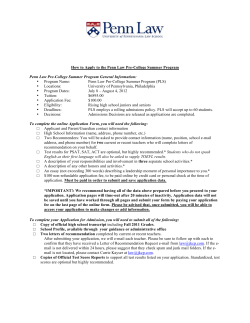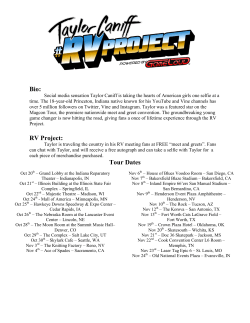
Global Sourcing and Vendor Risk Management in Supply Chains
Global Sourcing and Vendor Risk
Management in Supply Chains
Prof. T. R. Natesan Endowment
Lecture, ORSI, Chennai Chapter
November 23, 2010
Dr. A. Ravi Ravindran
Professor of Industrial Engineering
REFERENCE
Ravindran, A. Ravi, R. Ufuk Bilsel,
Vijay Wadhwa and Tao Yang, “Risk
Adjusted Multi Criteria Supplier
Selection Models With Applications”,
International Journal of Production
Research, vol. 48, No. 2, PP. 405424, January 2010.
Nov. 23, 2010
A. Ravi Ravindran (Penn State)
2
Agenda
Supplier Selection problem and its
Importance
Supplier Risk Management
Cost of supply disruptions
Risk Identification and Assessment
Risk Mitigation Strategies
Multi Criteria Models for Supplier Selection
Case Study Results
Nov. 23, 2010
A. Ravi Ravindran (Penn State)
3
Supplier Selection Process
In most procurement situations buyers have to
choose among a set of suppliers.
The buyer must choose which suppliers to order
from and how much to order from each supplier.
4
Importance of Sourcing Decisions
Wal-Mart assumed responsibility for global procurement from a
third party in 2001 to better coordinate entire global supply chain
from product development to delivery.
Raw material cost is 40-60% of production cost for US
manufacturers; for high tech companies, it can be up to 80%.
Example : General Motors
Cost of components and parts from outside suppliers exceed
50% of sales (2001 GM sales $180 billion)
Life cycle of a new car
18 months of concept phase, 18-24 months of
Development phase, 7 years of program life to build cars
for sales and 15 years of parts life for service
Major sourcing decisions with key suppliers are made 3
years before actual production!
5
Vendor Management
Cost Reduction Versus Risk Management
Risk management lags behind cost
reduction in procurement decisions
In a recent survey of companies, A.T.
Kearney found
74% have plans in place for reducing
procurement cost
Only 23% have plans in place to reduce supply
risk
Nov. 23, 2010
A. Ravi Ravindran (Penn State)
6
Practices affecting vendor
management
Global Sourcing
Benefit: Lower procurement cost
Risks: Supply disruptions, Longer &
uncertain lead times, Exchange rate and
security concerns
Outsourcing Non-core Functions
Benefits: Reduced cost and improved
service levels
Risks: Less flexibility and poor
quality/yield at supply source
Nov. 23, 2010
A. Ravi Ravindran (Penn State)
7
Practices affecting vendor
management (Continued)
Supply Consolidation
Benefits: Economies of scale and strong
strategic supply partnerships
Risks: Higher dependency on single
source and bankruptcy issues
JIT/Lean Approach
Benefits: Lower inventory cost
Risk: Even small disruptions can have
major impacts on production
Nov. 23, 2010
A. Ravi Ravindran (Penn State)
8
Importance of Vendor Management
Suppliers can change quickly impacting the
entire supply chain
Every day, 200 suppliers go bankrupt and a
similar number open for business
Every hour, 360 suppliers have court
judgments against them and 112 change
senior leadership
Supplier Monitoring is vital
Source: “The Danger Detectives”, Supply Management, Vol.8, No.
3, pp. 28-29, 2003.
Nov. 23, 2010
A. Ravi Ravindran (Penn State)
9
Costly Supply Disruptions Examples
18 day labor strike at Delphi Brake
Plant in March 1996 idled 26 GM
assembly plants, costing $900 million
in first quarter earnings.
Nokia-Ericsson Supplier Fire.
Each day of disruption in supply
network can cost an average of $50100 million (2003 study)
Nov. 23, 2010
A. Ravi Ravindran (Penn State)
10
Win vs. lose - Nokia and Ericsson story
Nov. 23, 2010
A. Ravi Ravindran (Penn State)
11
Hyundai Motor India
Major fire in June 2004 at a Tier-2
supplier Polyflex disrupts the “seat supply
chain” to HMIL.
No supply of seats for 3-4 days for the
Chennai plant.
Result
HMIL has to airlift seats from S. Korea to
meet export schedules.
Export “Backlog” of more than 1000 cars
(Source: The Economic Times, June 24, 2004)
Nov. 23, 2010
A. Ravi Ravindran (Penn State)
12
Land Rover and UPF Thompson
UPF-Thompson, sole supplier of chassis to
Land Rover, went bankrupt in 2001
Receiver KPMG demanded 50-70 million
Euros up front from Land Rover for the
supply of chassis
Court sided with KPMG declaring sole
supplier agreement is a valuable asset
A higher court injunction saved the day for
Land Rover from laying off 1400 plant
workers and many more at its network of
suppliers
Nov. 23, 2010
A. Ravi Ravindran (Penn State)
13
Supply Risk Management
Identify and Assess Supply Risks
Risk Occurrence
On time delivery, quality, cost/piece etc.
Risk Impact
Cost, revenue, entire supply chain
Develop Supply Risk Map
2x2 matrix
Frequency of occurrence – high & low
Risk Impact – high & low
Nov. 23, 2010
A. Ravi Ravindran (Penn State)
14
Supply Risk Mitigation Strategies
Low Occurrence, High Impact High Occurrence, High Impact
High
Implement joint process
improvements with suppliers,
have emergency plans, buy
contingent business
interruption insurance
Begin resourcing
efforts on these SKUs
redesign product
or find new suppliers
Risk
Impact
Low Occurrence, Low Impact High Occurrence, Low Impact
Low
Review and improve
quality assurance process
Low
Monitor supplier
performance
High
Risk Occurrence
Overview of a Research Project
funded by a Global IT Company
The objective was to demonstrate the use of
multiple criteria optimization models
incorporating supplier risk when making
sourcing decisions.
Two different risk models developed:
Value-at-Risk (VaR) for rare events.
Miss-the-target (MtT) risk for others.
Two phase risk-adjusted supplier selection
model.
Phase 1: Screen and shortlist suppliers.
Phase 2: Select suppliers and their order
quantities.
Solution methods were demonstrated using case
scenarios and company staff as decision makers.
Nov. 23, 2010
A. Ravi Ravindran (Penn State)
16
Definition and quantification of risk
•
•
We define risk as events (natural or man-made)
that cause SC disruptions
We quantify risk as being a function of Impact and
Occurrence:
Risk = f( Impact, Occurrence)
• Impact: Impact of events & potential loss
• Occurrence: Occurrence or frequency of risk
events
Nov. 23, 2010
A. Ravi Ravindran (Penn State)
17
Quantification of Risk
•
Risks are natural/man-made events that cause SC
disruptions
Type
Value-atRisk (VaR)
Miss-theTarget
(MtT) risk
Nov. 23, 2010
Occurrence
Rare
Frequent
Impact
Example
Severe
Hurricane,
strike, fire,
terrorist attack
Late delivery of
raw materials,
Mild to
low quality
Moderate
replenishment
A. Ravi Ravindran (Penn State)
18
VaR Type Risk
(Use Extreme Value Distributions)
1
1
K
x
x K 1 1
f ( x; , , K ) exp 1 K
1 K
Parameter Interpretation
K
Shape parameter
K>0, corresponds to a Frechet distribution,
K=0, corresponds to a Gumbel distribution,
K<0, corresponds to a Weibull distribution.
Nov. 23, 2010
δ
Scale parameter
λ
Location parameter
A. Ravi Ravindran (Penn State)
19
VaR Type Risk
Nov. 23, 2010
A. Ravi Ravindran (Penn State)
20
MtT Type Risk
(Use Taguchi’s Loss Functions)
Impact
Impact
S type
Nov. 23, 2010
Impact
N type
A. Ravi Ravindran (Penn State)
L type
21
Case Scenario
Phase 1: Short List Suppliers
Seven criteria with 14 attributes and 20 suppliers
Experiments to test multi criteria optimization
methods to rank suppliers:
Rating method
Pair-wise comparison method using Borda
count
Analytic Hierarchy Process (AHP).
Experiments to test Group Decision Making
methods for ranking suppliers.
Company staff as Decision Makers for both
experiments.
Nov. 23, 2010
A. Ravi Ravindran (Penn State)
22
MCDM Methods for Phase 1
Rating method: Each criterion is rated on a scale
of 1-10. weight associated with each criterion is
obtained through normalization.
Pair-wise comparison method using Borda
count: Based on pair wise comparison of criteria.
If P criteria are ranked, the most important
criterion gets P points, the second most important
gets (P-1), etc. Weights are calculated via
normalization.
Analytic Hierarchy Process (AHP): Pair wise
comparison of criteria with strength of preference
reported on a 1-9 scale.
Nov. 23, 2010
A. Ravi Ravindran (Penn State)
23
Criteria and Attributes
considered in Phase 1
No
1
2
3
4
5
6
7
8
9
10
11
12
13
14
Nov. 23, 2010
Criterion
Delivery
Business performance
Quality
Costs
Information technology
Long term improvement
Supply Disruption
Attribute
Accuracy
Capacity
Lead time
Financial status
Compatibility of business strategy
Defective rate
Responsiveness
Unit cost
Order change and cancellation charges
Online
EDI
Improvement programs
R&D activities
Risk score
A. Ravi Ravindran (Penn State)
24
Phase 1 Experiment
4 DMs participated the study and
provided the following data:
Rating of each attribute (1-10) scale
Pairwise comparison of attributes
Strength of preference (1-9 scale) for
pairwise comparisons
Experiment was conducted
electronically through survey sheets.
Nov. 23, 2010
A. Ravi Ravindran (Penn State)
25
Criteria rankings for different methods
by a single DM
Rank using
Nov. 23, 2010
Criterion
Rating
Borda
AHP
Delivery
1
2
2
Business Performance
3
3
3
Quality
1
1
1
Cost
5
4
4
IT
6
5
6
Long Term Improvement
6
7
7
Risk
3
6
5
A. Ravi Ravindran (Penn State)
26
Phase 1 Conclusions
Cost, quality and delivery are the
most important criteria,
No appreciable difference between
Procurement and R&D staff,
Borda Count results are in line with
AHP.
Borda Count is a good method for
ranking due to less cognitive burden
Results are consistent with prior studies
Nov. 23, 2010
A. Ravi Ravindran (Penn State)
27
Phase 2: Case Scenario
Phase 1 reduced initial supplier set of
twenty to five
Considered
multiple
products,
multiple buyers and multiple suppliers
with each supplier having multiple
price breaks
Allocate order quantity between
different suppliers to meet demand
Four conflicting criteria for decision
making.
Nov. 23, 2010
A. Ravi Ravindran (Penn State)
28
Multi Criteria Models for Supplier
Selection
Wadhwa and Ravindran
Computers & OR, Vol. 34, No. 12, pp.
3725-3737, Dec. 2007
Criteria – Cost, Quality, Lead time
Solution by Weighted Objective, Goal
Programming and Compromise
Programming methods
Goal programming more flexible
Nov. 23, 2010
A. Ravi Ravindran (Penn State)
29
Mathematical Model
Indices:
I
Set of products to be purchased
J
Set of buyers
K
Potential set of suppliers
M
Set of Price Breaks
Variables
X ijkm Number of units of product i supplied by vendor k
to buyer j at price level m
1 if a vendor is chosen
Zk
0 otherwise.
Nov. 23, 2010
A. Ravi Ravindran (Penn State)
30
Objective Functions
Minimize the
purchasing and fixed
cost.
Minimize the average
lead-time.
min pikm .xijkm Fk .z k
k
i j k m
l
min
d
i
j
k
Nov. 23, 2010
m
ij
i
Minimize loss due to
rejects (modeled as
MtT risk)
Minimize loss due to
hurricanes (modeled as
VaR risk)
ijk .xijkm
min
MtT .x
k
i
min
j
j
k
ijkm
m
VaR .x
k
i
A. Ravi Ravindran (Penn State)
j
k
ijkm
m
31
Model Constraints
Capacity Constraints
x
Demand Constraints
x
j
k
Maximum number of
suppliers
ijkm
CAPik .z k
ijkm
Dij i, j
i, k
m
m
z
k
N
k
Linearizing Constraints for xijkm (bikm bik ( m1) ). yijkm i, j, k 1 m mk
quantity discounts
xijkm (bikm bik ( m1) ). yijk( m1) i, j, k 1 m mk 1
Non-negativity
constraints.
Binary Constraints.
Nov. 23, 2010
xijkm 0
zk {0,1} yijkm {0,1}
A. Ravi Ravindran (Penn State)
32
Solution Method
Goal Programming (GP) is used to solve the multiobjective supplier selection problem.
Get from the decision maker goals/target. All the
goals may not be achievable.
Get decision maker’s preference on achieving the
goals.
Find a solution that will come as close as possible to
the stated goals in the specified order.
Nov. 23, 2010
A. Ravi Ravindran (Penn State)
33
GP Methods
Preemptive GP
Target set at 110% of the Ideal values.
Preemptive priorities, Price, MtT risk of quality, leadtime, VaR risk (from Phase 1 results)
Non-preemptive GP
Weights obtained from Phase 1.
Tchebycheff (Min-Max) GP
Minimize the maximum weighted deviation from the
targets. Weights obtained from Phase 1.
Fuzzy GP
Minimize the maximum weighted deviation from the
ideal values. Weights obtained from Phase 1.
Nov. 23, 2010
A. Ravi Ravindran (Penn State)
34
Problem Size
For a problem with 2 products, 2 buyers, 5
suppliers with each supplier having 2 price
breaks, the problem size is as follows:
Total number of continuous variables:
40.
Total number of binary variables: 45.
Total number of constraints:
Nov. 23, 2010
Capacity constraints: 10.
Demand constraints: 4.
Number of supplier constraint: 1.
Linearizing constraints: 60.
A. Ravi Ravindran (Penn State)
35
Value Path Approach
Efficient way to visualize different
solutions and their trade-offs
Display contains set of parallel lines; one
for each objective.
Value of each solution on the axis is that
solution value divided by the best
solution for that objective.
If two lines intersect then neither
solution dominates the other.
Nov. 23, 2010
A. Ravi Ravindran (Penn State)
36
Value Path Contd..
Nov. 23, 2010
A. Ravi Ravindran (Penn State)
37
Phase 2 Conclusions
Including conflicting criteria in supplier
selection improves the quality of decision
making process by providing valuable
tradeoff information that can be used to
optimize the supply network,
Goal programming models provide multiple
solutions that can be discussed by
procurement before selecting an optimal
procurement strategy.
Tradeoff information can be effectively
visualized using the Value Path Approach
Nov. 23, 2010
A. Ravi Ravindran (Penn State)
38
Summary
Vendor management plays a big role in
Supply Chain efficiency
Increasingly companies have to adjust current
domestic strategies to accommodate global
needs
Several factors impact the chance of success
in Global Sourcing
Consider cost and risk in vendor management
Monitor supplier performance
Note: There is No Reward without Risk!
Nov. 23, 2010
A. Ravi Ravindran (Penn State)
39
© Copyright 2025









